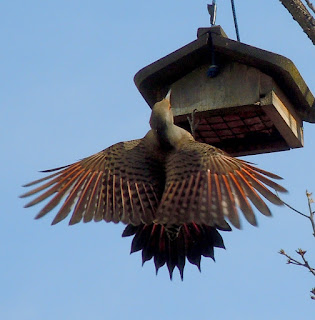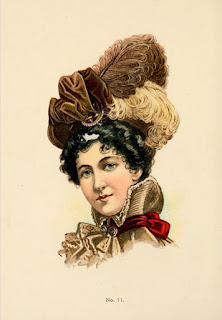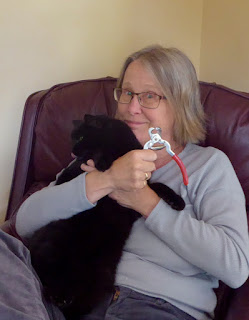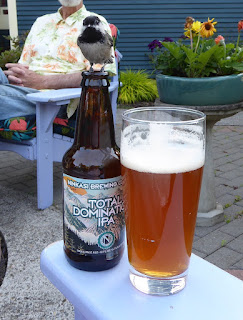 I told you about our chief chickadee Studley Windowson and his new duds. The boy is all freshly feathered out for the next year. What is a feather, anyway? Feathers are the fanciest thing you can make out of keratin, a protein. Not you personally. All you can do is make sparse and peculiar outgrowths of hair, ratty fingernails, and dandruff. We humans might dye our keratin or paint it but we don’t make magnificent spiraled horns out of it or anything as spiffy as feathers. We have to compensate for our feeble keratin skills with art, music, and certain kinds of comedy.
I told you about our chief chickadee Studley Windowson and his new duds. The boy is all freshly feathered out for the next year. What is a feather, anyway? Feathers are the fanciest thing you can make out of keratin, a protein. Not you personally. All you can do is make sparse and peculiar outgrowths of hair, ratty fingernails, and dandruff. We humans might dye our keratin or paint it but we don’t make magnificent spiraled horns out of it or anything as spiffy as feathers. We have to compensate for our feeble keratin skills with art, music, and certain kinds of comedy.
Or by swiping feathers off a bird that wasn’t done with them and sticking them on ourselves. Historically, nobody waited for the feathers to fall off the bird, but instead plucked the animal, such as the egret, nearly into extinction, which is a shame, but damn, the hats were fabulous.
 Keratin isn’t living tissue, which is why you can, if you have a super nice cat, clip her claws more than once. But because it isn’t living tissue, it can’t renew itself when it gets worn out. So the feathers fall off the bird periodically and the bird starts over.
Keratin isn’t living tissue, which is why you can, if you have a super nice cat, clip her claws more than once. But because it isn’t living tissue, it can’t renew itself when it gets worn out. So the feathers fall off the bird periodically and the bird starts over.
Once you’ve made yourself a feather, you’d best take good care of it. You have to preen it, and nibble at it, and straighten out the little interlocking side shoots off the shaft, and keep it in good condition, so you can fly properly or repel water or stay warm or whatever you need your feathers to do. But eventually there’s going to be some wear and tear. And so, the feathers will have to be replaced by brand new ones. A warbler that never molts will end up being a sad little golf ball with bristles and stubs, just parked on the ground waiting to be someone’s lunch. I assume. It doesn’t happen.
 Some birds molt once a year. Some birds do a half-assed job of it once a year and a whole-assed job later. Only a few do a complete molt twice annually, and those are the ones that really beat up their feather allocation by flying through windmills. Ha ha! Not really, just dense vegetation and such. The birds that fly through windmills quit molting altogether.
Some birds molt once a year. Some birds do a half-assed job of it once a year and a whole-assed job later. Only a few do a complete molt twice annually, and those are the ones that really beat up their feather allocation by flying through windmills. Ha ha! Not really, just dense vegetation and such. The birds that fly through windmills quit molting altogether.
Studley is a once-a-year man and as such he looks as good now as he ever has or will. Some birds drop all their feathers at once, such as your duck, who is then temporarily flightless and moves to the center of the pond and tries not to get nabbed by anything, which is why it’s called a “duck.” (The goose has the same issue but knows how to defend itself, which is why it’s called a “goose,” and you shouldn’t turn your back on it.)
But most birds are more methodical. They’ll drop their feathers and replace them in a particular order and that way they can stay in the air, if they’ve a mind to. Crows in August show grand gaps in their wings and tails but they’re never actually grounded. They’re a little irritable though because they’re vain and they know they look like crap. They’d totally make egret feather hats if they had the materials.
 For many birds, the sexes are differentiated by their outfits, and many also look different as babies than they do as adults. A particularly annoying form of bird looks different after every molt for several years in a row. This is utterly fine if you are a talented birder and can squint at a distant dot and confidently (some would say arrogantly) mark it down as a three-year-old herring gull as opposed to, say, a two-year-old herring gull, a junkyard scrabble-pigeon, or an eye floater. Gulls in general earn their keep in the birding world by being difficult to identify but theoretically solvable. Normal people can get back at birders by calling all these birds and their distant kin “seagulls,” which drives birders crazy. Keep that in your back pocket. They’ll correct you, and you’ll just shrug at them because you don’t care. They’ll feel superior and impotent at the same time, sort of like liberals.
For many birds, the sexes are differentiated by their outfits, and many also look different as babies than they do as adults. A particularly annoying form of bird looks different after every molt for several years in a row. This is utterly fine if you are a talented birder and can squint at a distant dot and confidently (some would say arrogantly) mark it down as a three-year-old herring gull as opposed to, say, a two-year-old herring gull, a junkyard scrabble-pigeon, or an eye floater. Gulls in general earn their keep in the birding world by being difficult to identify but theoretically solvable. Normal people can get back at birders by calling all these birds and their distant kin “seagulls,” which drives birders crazy. Keep that in your back pocket. They’ll correct you, and you’ll just shrug at them because you don’t care. They’ll feel superior and impotent at the same time, sort of like liberals.
But that is all just one more point in favor of Studley and his cohort. Not only do Studley and Marge look alike, but they stay alike all year long, and produce children that look just like them. That, there, is a considerate bird.
As with gulls, so with eagles. Experienced birders can tell the age of the eagle (at least until adulthood) by how much white they are sporting on their heads. Some can even tell individual eagles from the shape of their nares and the flatness or roundness of their heads. All this is possible, mind you, due to the prevalence of eagle cams, which have given experienced birders yet another way to flaunt their knowledge over us backyard birders.
Eagles have nares?
Wait. What are nares?
Why does this remind me of "clams got legs?"
Nares are what the birders call their nostrils. Don't know why they don't call them nostrils, but they don't.
You can't flare them.
I just read in the New York Times that "The number of birds in the United States and Canada has declined by 3 billion".
I do get a bit miffed when I'm parked at the grocery store and a bird leaves a little something on my windshield. Perhaps I will be a little bit kinder now and just get my husband to wash it off.
Or you could lower your standards. I wash my car every four years whether it needs it or not and I park under a telephone wire. It would be worse if it weren't for all the rain.
Remember dinosaurs had feathers too. Just imagine the hats we could have made with those. If we could figure out a safe way of plucking a T-rex.
The poor dears couldn't pluck themselves…
Pretty sure T-Rex didn't have feathers. Pterodactyls on the other hand would have enough for a feather bed.
And some plumage just fades so badly that you can hardly recognise to whom it belongs. They get more difficult to sex, too, not that it's any of our concern.
"Not that it's any of our concern…" HA HA HA HA HA
And some birds (ducks particularly) put on different feathers when sex is at the forefront of their minds. Their own feathers, not stolen ones. When breeding season is over they wear 'eclipse' plumage which is much less striking.
It's a lot of trouble to go through for a three-second cloacal kiss or two. But it's nice for us.
Okay, wait a minute, that doesn't apply to ducks. Ducks do a lot more than cloacal kissing.
Who owns the beautiful wings in the first photo? Is that Studley?
I'd lose an arm if I tried to clip Lola's claws. I schedule a visit to the vet for that on a day when they have an extra handler, one to hold the cat and one to do the clipping.
That first bird is a northern flicker – red-shafted. Here in the east (specifically in Virginia) we have the yellow-shafted version. I envy the westerners their red ones. It's a woodpecker. But a woodpecker that specializes in eating ants and thus is found pecking around on the ground fairly often, which other woodpeckers don't do.
I think ours specialize in hammering on metal chimneys.
That's the value of going on a field trip with a birder par excellence – they can ID those difficult plumages and I can add another bird to my life list. Although it doesn't count if I don't get a good view of it myself. And it only half counts if I don't get a photo of it as proof.
The good news, for me, is I can get the same life bird dozens of times.
What a great shot that first photo is! The last one isn't half bad either 🙂
I didn't realize that different birds molt on different schedules and in different amounts. Cool.
That flicker is landing on our suet feeder. I love the tail shape too!
Flicker! Or as my daughter called them, well…nevermind.
Always use a big font.
i am ERIC BRUNT by name. Greetings to every one that is reading this testimony. I have been rejected by my wife after three(3) years of marriage just because another Man had a spell on her and she left me and the kid to suffer. one day when i was reading through the web, i saw a post on how this spell caster on this address AKHERETEMPLE@gmail.com have help a woman to get back her husband and i gave him a reply to his address and he told me that a man had a spell on my wife and he told me that he will help me and after 3 days that i will have my wife back. i believed him and today i am glad to let you all know that this spell caster have the power to bring lovers back. because i am now happy with my wife. Thanks for helping me Dr Akhere contact him on email: AKHERETEMPLE@gmail.com
or
call/whatsapp:+2349057261346
i am ERIC BRUNT by name. Greetings to every one that is reading this testimony. I have been rejected by my wife after three(3) years of marriage just because another Man had a spell on her and she left me and the kid to suffer. one day when i was reading through the web, i saw a post on how this spell caster on this address AKHERETEMPLE@gmail.com have help a woman to get back her husband and i gave him a reply to his address and he told me that a man had a spell on my wife and he told me that he will help me and after 3 days that i will have my wife back. i believed him and today i am glad to let you all know that this spell caster have the power to bring lovers back. because i am now happy with my wife. Thanks for helping me Dr Akhere contact him on email: AKHERETEMPLE@gmail.com
or
call/whatsapp:+2349057261346
WE SHOULD FUCK. Like right now, right here. Hard, fast. Pin me down, kiss me hard, look me in the eyes and fuck me like you’ve never fucked someone before. Hey, i am looking for an online sexual partner 😉 Click on my boobs if you are interested (. )( .)